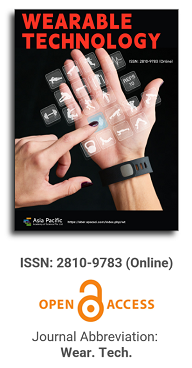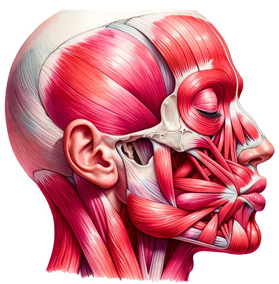

This paper delves deeply into the innovative realm of integrating human emotions with wearable technology. The primary focus is on the conceptualization and development of a kiss transfer device that harnesses the power of wearable technology to bridge the physical gap in human-human interactions. By investigating the intricate nuances of the human-human kissing process, the research seeks to replicate this intimate gesture through a technological medium. The paper not only elaborates on the anatomy, evolution, and hormonal dynamics of kissing but also underscores the transformative potential of wearable technology in capturing and transmitting these intimate moments. This exploration opens up new horizons for long-distance relationships, offering a tangible touchpoint that goes beyond traditional communication methods. Through this pioneering work, the research positions wearable technology as not just a tool for communication but as an extension of our human emotions and expressions.

AI and machine learning applications in wearable health devices
Vol 5, Issue 1, 2024
Download PDF
Abstract
By enabling real-time monitoring, early diagnosis, and tailored therapies, wearable health technology combining artificial intelligence and machine learning has transformed healthcare. Wearables combine Internet of Things (IoT), cloud computing, and artificial intelligence (AI) using algorithms to monitor vital signs, including heart rate, blood glucose levels, and oxygen saturation. This enables predictive insights into health conditions, maximizes therapies, and supports remote healthcare options. Even if their potential use is rather high, data privacy, model generalization, regulatory validation, and accessibility remain issues. Generative artificial intelligence and federated learning both help privacy and performance. Predictive modeling, AR/VR, and blockchain technology will drive wearable health devices forward. Artificial intelligence-powered wearables impact world health since they provide competitively priced, scalable solutions for poor populations. By means of overcoming obstacles, multidisciplinary teamwork provides fair, safe, and changing healthcare service.
Keywords
References
- Wang WH, Hsu WS. Integrating Artificial Intelligence and Wearable IoT System in Long-Term Care Environments. Sensors. 2023; 23(13): 5913. doi: 10.3390/s23135913
- Moshawrab M, Adda M, Bouzouane A, et al. Smart Wearables for the Detection of Cardiovascular Diseases: A Systematic Literature Review. Sensors. 2023; 23(2): 828. doi: 10.3390/s23020828
- Shajari S, Kuruvinashetti K, Komeili A, et al. The Emergence of AI-Based Wearable Sensors for Digital Health Technology: A Review. Sensors. 2023; 23(23): 9498. doi: 10.3390/s23239498
- Guan Z, Li H, Liu R, et al. Artificial intelligence in diabetes management: Advancements, opportunities, and challenges. Cell Reports Medicine. 2023; 4(10): 101213. doi: 10.1016/j.xcrm.2023.101213
- Cuperus LJA, Bult L, van Zelst CM, et al. Wearable technology for detection of COPD exacerbations: feasibility of the Health Patch. ERJ Open Research. 2024; 10(6): 00396–02024. doi: 10.1183/23120541.00396-2024
- Attivissimo F, D’Alessandro VI, De Palma L, et al. Non-Invasive Blood Pressure Sensing via Machine Learning. Sensors. 2023; 23(19): 8342. doi: 10.3390/s23198342
- Papalamprakopoulou Z, Stavropoulos D, Moustakidis S, et al. Artificial intelligence-enabled atrial fibrillation detection using smartwatches: current status and future perspectives. Frontiers in Cardiovascular Medicine. 2024; 11. doi: 10.3389/fcvm.2024.1432876
- Bergenstal RM. Roadmap to the Effective Use of Continuous Glucose Monitoring: Innovation, Investigation, and Implementation. Diabetes Spectrum. 2023; 36(4): 327–336. doi: 10.2337/dsi23-0005
- Silva GFS, Fagundes TP, Teixeira BC, et al. Machine Learning for Hypertension Prediction: a Systematic Review. Current Hypertension Reports. 2022; 24(11): 523–533. doi: 10.1007/s11906-022-01212-6
- Khan AJMOR, Islam SAM, Sarkar A, et al. Real-time Predictive Health Monitoring using AI-driven Wearable Sensors: Enhancing Early Detection and Personalized Interventions in Chronic Disease Management. IJFMR—International Journal for Multidisciplinary Research. 2024; 6(5). doi: 10.36948/ijfmr.2024.v06i05.28497.
- Canali S, Schiaffonati V, Aliverti A. Challenges and recommendations for wearable devices in digital health: Data quality, interoperability, health equity, fairness. Mulvaney S, ed. PLOS Digital Health. 2022; 1(10): e0000104. doi: 10.1371/journal.pdig.0000104
- Amendolara A, Pfister D, Settelmayer M, et al. An Overview of Machine Learning Applications in Sports Injury Prediction. Cureus. Published online September 28, 2023. doi: 10.7759/cureus.46170
- Seçkin AÇ, Ateş B, Seçkin M. Review on Wearable Technology in Sports: Concepts, Challenges and Opportunities. Applied Sciences. 2023; 13(18): 10399. doi: 10.3390/app131810399
- Abd-alrazaq A, AlSaad R, Aziz S, et al. Wearable Artificial Intelligence for Anxiety and Depression: Scoping Review. Journal of Medical Internet Research. 2023; 25: e42672. doi: 10.2196/42672
- Hoose S, Králiková K. Artificial Intelligence in Mental Health Care: Management Implications, Ethical Challenges, and Policy Considerations. Administrative Sciences. 2024; 14(9): 227. doi: 10.3390/admsci14090227
- Rogan J, Bucci S, Firth J. Health Care Professionals’ Views on the Use of Passive Sensing, AI, and Machine Learning in Mental Health Care: Systematic Review With Meta-Synthesis. JMIR Mental Health. 2024; 11: e49577. doi: 10.2196/49577
- Olawade DB, Wada OZ, Odetayo A, et al. Enhancing mental health with Artificial Intelligence: Current trends and future prospects. Journal of Medicine, Surgery, and Public Health. 2024; 3: 100099. doi: 10.1016/j.glmedi.2024.100099
- Bhimaraj A. Remote Monitoring of Heart Failure Patients. Methodist DeBakey Cardiovascular Journal. 2013; 9(1): 26. doi: 10.14797/mdcj-9-1-26
- Meena JS, Choi SB, Jung SB, et al. Electronic textiles: New age of wearable technology for healthcare and fitness solutions. Materials Today Bio. 2023; 19: 100565. doi: 10.1016/j.mtbio.2023.100565
- Lim TH, Abdullah AF, Lim SA. Improving quality of wearable biosensor data through artificial intelligence. Biosensors in Precision Medicine. Published online 2024: 315–344. doi: 10.1016/b978-0-443-15380-8.00011-4
- Shumba AT, Montanaro T, Sergi I, et al. Wearable Technologies and AI at the Far Edge for Chronic Heart Failure Prevention and Management: A Systematic Review and Prospects. Sensors. 2023; 23(15): 6896. doi: 10.3390/s23156896
- Cilliers L. Wearable devices in healthcare: Privacy and information security issues. Health Information Management Journal. 2019; 49(2–3): 150–156. doi: 10.1177/1833358319851684
- Bouderhem R. Privacy and Regulatory Issues in Wearable Health Technology. In: Proceedings of the Engineering Proceedings; 2023. pp. 87.
- FDA. Artificial Intelligence and Machine Learning in Software as a Medical Device. Center for Devices and Radiological Health FDA; 2024.
- Gupta P, Pandey MK. Role of AI for Smart Health Diagnosis and Treatment. Smart Medical Imaging for Diagnosis and Treatment Planning. Chapman and Hall/CRC; 2024. pp. 23–45.
- Anandaram H, Gupta D, Priyadarsini ChI, et al. Implementation of Machine Learning for Smart Wearables in the Healthcare Sector. Driving Smart Medical Diagnosis Through AI-Powered Technologies and Applications. IGI Global: Hershey; 2024. pp. 207–221.
- Shafik W. Artificial Intelligence-Enabled Internet of Medical Things (AIoMT) in Modern Healthcare Practices. Clinical Practice and Unmet Challenges in AI-Enhanced Healthcare Systems. IGI Global: Hershey; 2024. pp. 43–70.
Supporting Agencies
Copyright (c) 2024 Muhammad Nadir Shabbir, Duong Thuy Linh
License URL: https://creativecommons.org/licenses/by/4.0/

Prof. Zhen Cao
College of Information Science & Electronic Engineering, Zhejiang University
China, China
Processing Speed
-
-
-
- <5 days from submission to initial review decision;
- 62% acceptance rate
-
-
Asia Pacific Academy of Science Pte. Ltd. (APACSCI) specializes in international journal publishing. APACSCI adopts the open access publishing model and provides an important communication bridge for academic groups whose interest fields include engineering, technology, medicine, computer, mathematics, agriculture and forestry, and environment.





